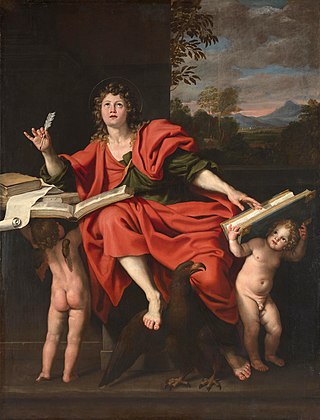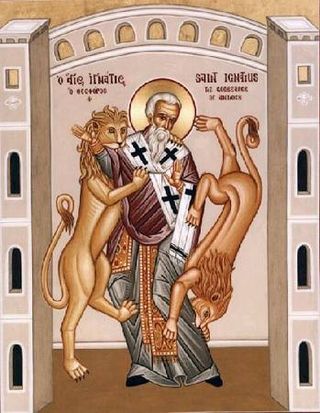Related Research Articles
In the Platonic, Neopythagorean, Middle Platonic, and Neoplatonic schools of philosophy, the demiurge is an artisan-like figure responsible for fashioning and maintaining the physical universe. The Gnostics adopted the term demiurge. Although a fashioner, the demiurge is not necessarily the same as the creator figure in the monotheistic sense, because the demiurge itself and the material from which the demiurge fashions the universe are both considered consequences of something else. Depending on the system, they may be considered either uncreated and eternal or the product of some other entity.

Gnosticism is a collection of religious ideas and systems that coalesced in the late 1st century AD among Jewish and early Christian sects. These various groups emphasized personal spiritual knowledge (gnosis) above the proto-orthodox teachings, traditions, and authority of religious institutions.

Irenaeus was a Greek bishop noted for his role in guiding and expanding Christian communities in the southern regions of present-day France and, more widely, for the development of Christian theology by combating heterodox or Gnostic interpretations of Scripture as heresy and defining proto-orthodoxy. Originating from Smyrna, he had seen and heard the preaching of Polycarp, who in turn was said to have heard John the Evangelist, and thus was the last-known living connection with the Apostles.

Montanism, known by its adherents as the New Prophecy, was an early Christian movement of the late 2nd century, later referred to by the name of its founder, Montanus. Montanism held views about the basic tenets of Christian theology similar to those of the wider Christian Church, but it was labelled a heresy for its belief in new prophetic figures. The prophetic movement called for a reliance on the spontaneity of the Holy Spirit and a more conservative personal ethic.

Marcion of Sinope was a theologian in early Christianity. Marcion preached that God had sent Jesus Christ, who was distinct from the "vengeful" God (Demiurge) who had created the world. He considered himself a follower of Paul the Apostle, whom he believed to have been the only true apostle of Jesus Christ; his doctrine is called Marcionism. Marcion published the earliest record of a canon of New Testament books.
Marcionism was an early Christian dualistic belief system that originated with the teachings of Marcion of Sinope in Rome around the year 144. Marcion was an early Christian theologian, evangelist, and an important figure in early Christianity. He was the son of a bishop of Sinope in Pontus. About the middle of the 2nd century (140–155) he traveled to Rome, where he joined the Syrian Gnostic Cerdo.
Cerinthus was an early Gnostic, who was prominent as a heresiarch in the view of the early Church Fathers. Contrary to the Church Fathers, he used the Gospel of Cerinthus, and denied that the Supreme God made the physical world. In Cerinthus' interpretation, the Christ descended upon Jesus at baptism and guided him in ministry and the performing of miracles, but left him at the crucifixion. Similarly to the Ebionites, he maintained that Jesus was not born of a virgin, but was a mere man, the biological son of Mary and Joseph.
Valentinus was the best known and, for a time, most successful early Christian Gnostic theologian. He founded his school in Rome. According to Tertullian, Valentinus was a candidate for bishop but started his own group when another was chosen.

Elaine Pagels, née Hiesey, is an American historian of religion. She is the Harrington Spear Paine Professor of Religion at Princeton University. Pagels has conducted extensive research into early Christianity and Gnosticism.

The authorship of the Johannine works has been debated by biblical scholars since at least the 2nd century AD. The debate focuses mainly on the identity of the author(s), as well as the date and location of authorship of these writings.
Heracleon was a Gnostic who flourished about AD 175, probably in the south of Italy. He is the author of the earliest known commentary on a book that would eventually be included in the Christian New Testament with his commentary on the Gospel of John, although only fragmentary quotes survive. He is described by Clement of Alexandria as the most esteemed (δοκιμώτατος) of the school of Valentinus; and, according to Origen, said to have been in personal contact (γνώριμος) with Valentinus himself. He is barely mentioned by Irenaeus (2.4.1) and by Tertullian. The common source of Philaster and Pseudo-Tertullian contained an article on Heracleon between those on Ptolemaeus and Secundus, and on Marcus and Colarbasus.
Valentinianism was one of the major Gnostic Christian movements. Founded by Valentinus in the 2nd century AD, its influence spread widely, not just within Rome but also from Northwest Africa to Egypt through to Asia Minor and Syria in the East. Later in the movement's history it broke into an Eastern and a Western school. Disciples of Valentinus continued to be active into the 4th century AD, after the Roman Emperor Theodosius I issued the Edict of Thessalonica, which declared Nicene Christianity as the State church of the Roman Empire.

The term proto-orthodox Christianity or proto-orthodoxy describes the early Christian movement that was the precursor of Christian orthodoxy. It was coined by Bentley Layton, but is often erroneously attributed to New Testament scholar Bart D. Ehrman. Ehrman argues that this group from the moment it became prominent by the end of the third century, "stifled its opposition, it claimed that its views had always been the majority position and that its rivals were, and always had been, 'heretics', who willfully 'chose' to reject the 'true belief'." In contrast, Larry W. Hurtado argues that proto-orthodox Christianity is rooted in first-century Christianity.
Heresy in Christianity denotes the formal denial or doubt of a core doctrine of the Christian faith as defined by one or more of the Christian churches.

Against Heresies, sometimes referred to by its Latin title Adversus Haereses, is a work of Christian theology written in Greek about the year 180 by Irenaeus, the bishop of Lugdunum.
The Tripartite Tractate is a Valentinian Gnostic work. The date is estimated to the second half of the third century or the fourth century but is "most likely based on an earlier Greek version." It is the second-longest text in the Nag Hammadi library. It is the fifth tractate of the first codex, known as the Jung Codex. It is untitled, and instead it gets its name "from the fact that the ancient copyist divided the text with decorative markings in two places, thus separating the tractate into three parts." The first part describes the relationship between the Father, the Logos, the Church, and the aeons. The second part contains the Gnostic creation narrative, in which man is created by the Demiurge and is a mixture of both spiritual and material substances. The third part explains the Savior's role in salvation.

Christianity in the ante-Nicene period was the time in Christian history up to the First Council of Nicaea. This article covers the period following the Apostolic Age of the first century, c. 100 AD, to Nicaea in 325 AD.

Traditionally in Christianity, orthodoxy and heresy have been viewed in relation to the "orthodoxy" as an authentic lineage of tradition. Other forms of Christianity were viewed as deviant streams of thought and therefore "heterodox", or heretical. This view was challenged by the publication of Walter Bauer's Rechtgläubigkeit und Ketzerei im ältesten Christentum in 1934. Bauer endeavored to rethink Early Christianity historically, independent from the views of the current church. He stated that the 2nd-century church was very diverse and included many "heretical" groups that had an equal claim to apostolic tradition. Bauer interpreted the struggle between the orthodox and heterodox to be the "mainstream" Church of Rome struggling to attain dominance. He presented Edessa and Egypt as places where the "orthodoxy" of Rome had little influence during the 2nd century. As he saw it, the theological thought of the "Orient" at the time would later be labeled "heresy". The response by modern scholars has been mixed. Some scholars clearly support Bauer's conclusions and others express concerns about his "attacking [of] orthodox sources with inquisitional zeal and exploiting to a nearly absurd extent the argument from silence." However, modern scholars have critiqued and updated Bauer's model.
The Treatise on the Resurrection is an ancient Gnostic or quasi-Gnostic Christian text which was found at Nag Hammadi, Egypt. It is also sometimes referred to as "The Letter to Rheginos" because it is a letter responding to questions about the resurrection posed by Rheginos, who may have been a non-Gnostic Christian.
In many Gnostic systems, various emanations of God are known by such names as One, Monad, Aion teleos, Bythos, Arkhe, Proarkhe and as Aeons. In different systems these emanations are differently named, classified, and described. In Basilidian Gnosis they are called sonships ; according to Marcus, they are numbers and sounds; in Valentinianism they form male/female pairs called syzygies.
References
Footnotes
- ↑ Seban 1999. p. 947.
- ↑ Pagels 1989. pp. xxix, 154.
- ↑ Pagels 1989. pp. 36, 39, 161, 162.
- ↑ Pagels 1989. pp. 39, 162.
Bibliography
- Pagels, Elaine (1989). The Gnostic Gospels. New York: Vintage Books. ISBN 0-679-72453-2.
- Seban, Jean-Loup (1999). Audi, Robert (ed.). The Cambridge Dictionary of Philosophy. Cambridge: Cambridge University Press. ISBN 0-521-63722-8.